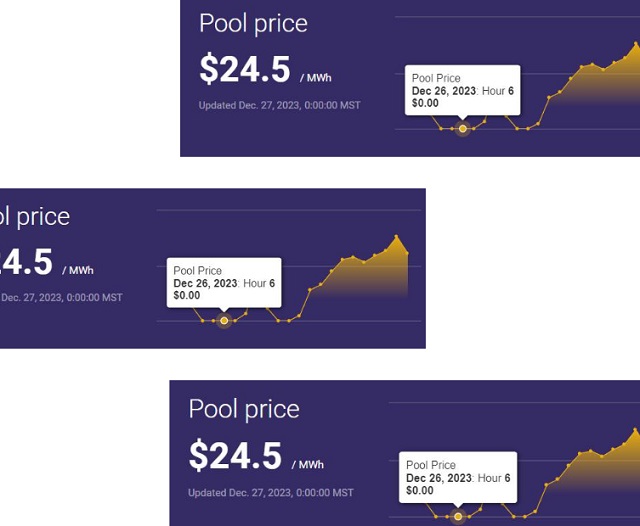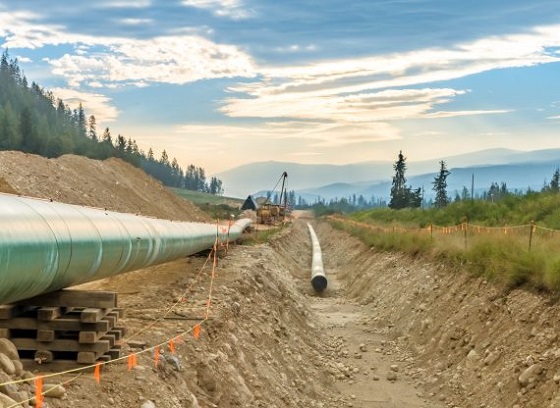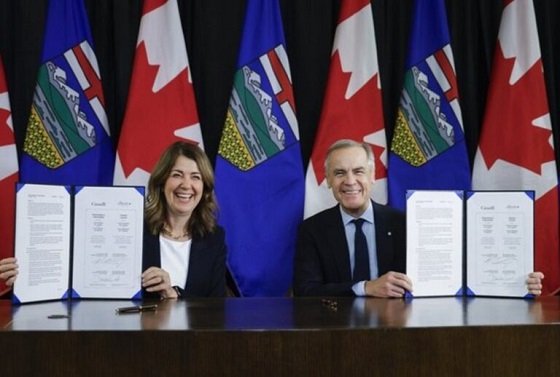Alberta
Boxing Day Special! Alberta had free power for several hours, and that’s not a good thing

From the Frontier Centre for Public Policy
Imagine, if you will, a Boxing Day sale where everything was free for everyone across every store at the same time, for several hours.
And imagine if in early morning hours of Dec. 26, Best Buy, Staples, Walmart, and indeed every single store in the entire economy got paid precisely zero dollars for their wares for several hours that morning.
Preposterous, you say!
Indeed, it did happen, in Alberta’s free-wheeling unregulated electrical market. The pool price, as recorded by the Alberta Electric System Operator (AESO) was $0.00 per megawatt at 4-7 a.m., and from 11 a.m. until noon.
And as a pool price, that means unless there’s some other contract going, that’s the price all generators get paid.
I might not have an MBA, but I’m fairly certain no business model in the world can survive getting paid nothing at all for their product for terribly long. If McDonalds, Burger King and Tim Horton’s all gave away their breakfasts on Dec. 26 to all comers, they couldn’t do it for long before someone would realize this is idiocy and shut the doors.
So what was happening during those wee hours in the morning, as the Boxing Day shoppers were in line for their flat screen TVs? It was quite windy in Alberta.
X bot account @ReliableAB, which logs hourly reports of the AESO minute-by-minute reporting of the grid showed that wind generation was just a hummin’. For several weeks, Alberta wind power has been been frequently pumping out high numbers, often in excess of 70 per cent of its nameplate capacity. One would think this would be a great thing, right? It’s finally doing what it’s supposed to do.
At 4:38 a.m., @ReliableAB reported Alberta’s now 45 wind farms were putting out 3,508 megawatts of the installed capacity of 4,481 megawatts while the pool price was zero.
At that point, wind was generating a full 33 per cent of total generation, which again, sounds like great news.
It was during one of the deadest periods of economic activity in the whole year, the night after Christmas. Demand in Alberta was low, with an internal load of 9,632 megawatts. The lack of demand happened to coincide with lots of surplus power being dumped onto the grid.
(As it was still dark, solar wasn’t a factor.)
What to do? How about sell as much as you can?
And that’s what happened. Alberta was pumping out 995 megawatts of power exports to its neighbours, 967 megawatts to BC, 26 to Saskatchewan, and two megawatts to Montana.
This situation is also the converse of what I’ve been reporting on over almost precisely 24 months, the frequent collapse of wind power generation in Alberta. Almost every time that has happened, the pool price shoots up, often hitting $700, $800, $900 or even the theoretical maximum of $999.99 per megawatt hour. If the maximum was $2,000, I’m willing to bet it would have hit those heights, too. And the integral under that graph – what consumers get on their bill – is horrendous.
So here we have renewable, “green” power in surplus, driving prices down for everyone, and so much so that it can benefit the neighbours, too.
But therein is the fundamental problem. No one, not Best Buy, McDonalds or Capital Power can produce product for nothing, and definitely not for extended periods. There is a cost to generating power, be it capital or fuel or operating costs. Nor can they sell their products, be it flat screen TVs, hamburgers or electricity for next to nothing, either. The entire economic model will collapse, and then what? Who will provide the power then?
When I wrote my first story on Alberta wind power on Dec. 28, 2021, the province had 2,269 megawatts on nameplate wind generation capacity. It’s now double that, at 4,481 megawatts, a level where big swings in wind power production have a huge impact. And Alberta’s last coal plant will switch to natural gas in a few months.
And there’s more wind coming. Oct. 24, the Calgary Herald noted, “More than 3,500 megawatts of renewable power generation projects are now under construction in Alberta.
“By the end of August, the AESO received 74 wind and solar project applications after the moratorium was announced, (Premier Danielle) Smith noted.”
What’s going to happen when all that comes online, when Alberta will have around 9,600 megawatts of wind and solar, almost equal to daily demand? Will the grid be flooded with power so cheap that reliable, dispatchable power generators can’t stay in business, only to see prices skyrocket when wind and solar inevitably fail, as they frequently do, and at the worst times?
Sounds like a recipe for utter chaos. And blackouts.
Brian Zinchuk is editor and owner of Pipeline Online, and occasional contributor to the Frontier Centre for Public Policy. He can be reached at [email protected].
Alberta
Alberta Next Panel calls for less Ottawa—and it could pay off

From the Fraser Institute
By Tegan Hill
Last Friday, less than a week before Christmas, the Smith government quietly released the final report from its Alberta Next Panel, which assessed Alberta’s role in Canada. Among other things, the panel recommends that the federal government transfer some of its tax revenue to provincial governments so they can assume more control over the delivery of provincial services. Based on Canada’s experience in the 1990s, this plan could deliver real benefits for Albertans and all Canadians.
Federations such as Canada typically work best when governments stick to their constitutional lanes. Indeed, one of the benefits of being a federalist country is that different levels of government assume responsibility for programs they’re best suited to deliver. For example, it’s logical that the federal government handle national defence, while provincial governments are typically best positioned to understand and address the unique health-care and education needs of their citizens.
But there’s currently a mismatch between the share of taxes the provinces collect and the cost of delivering provincial responsibilities (e.g. health care, education, childcare, and social services). As such, Ottawa uses transfers—including the Canada Health Transfer (CHT)—to financially support the provinces in their areas of responsibility. But these funds come with conditions.
Consider health care. To receive CHT payments from Ottawa, provinces must abide by the Canada Health Act, which effectively prevents the provinces from experimenting with new ways of delivering and financing health care—including policies that are successful in other universal health-care countries. Given Canada’s health-care system is one of the developed world’s most expensive universal systems, yet Canadians face some of the longest wait times for physicians and worst access to medical technology (e.g. MRIs) and hospital beds, these restrictions limit badly needed innovation and hurt patients.
To give the provinces more flexibility, the Alberta Next Panel suggests the federal government shift tax points (and transfer GST) to the provinces to better align provincial revenues with provincial responsibilities while eliminating “strings” attached to such federal transfers. In other words, Ottawa would transfer a portion of its tax revenues from the federal income tax and federal sales tax to the provincial government so they have funds to experiment with what works best for their citizens, without conditions on how that money can be used.
According to the Alberta Next Panel poll, at least in Alberta, a majority of citizens support this type of provincial autonomy in delivering provincial programs—and again, it’s paid off before.
In the 1990s, amid a fiscal crisis (greater in scale, but not dissimilar to the one Ottawa faces today), the federal government reduced welfare and social assistance transfers to the provinces while simultaneously removing most of the “strings” attached to these dollars. These reforms allowed the provinces to introduce work incentives, for example, which would have previously triggered a reduction in federal transfers. The change to federal transfers sparked a wave of reforms as the provinces experimented with new ways to improve their welfare programs, and ultimately led to significant innovation that reduced welfare dependency from a high of 3.1 million in 1994 to a low of 1.6 million in 2008, while also reducing government spending on social assistance.
The Smith government’s Alberta Next Panel wants the federal government to transfer some of its tax revenues to the provinces and reduce restrictions on provincial program delivery. As Canada’s experience in the 1990s shows, this could spur real innovation that ultimately improves services for Albertans and all Canadians.
Alberta
Ottawa-Alberta agreement may produce oligopoly in the oilsands

From the Fraser Institute
By Jason Clemens and Elmira Aliakbari
The federal and Alberta governments recently jointly released the details of a memorandum of understanding (MOU), which lays the groundwork for potentially significant energy infrastructure including an oil pipeline from Alberta to the west coast that would provide access to Asia and other international markets. While an improvement on the status quo, the MOU’s ambiguity risks creating an oligopoly.
An oligopoly is basically a monopoly but with multiple firms instead of a single firm. It’s a market with limited competition where a few firms dominate the entire market, and it’s something economists and policymakers worry about because it results in higher prices, less innovation, lower investment and/or less quality. Indeed, the federal government has an entire agency charged with worrying about limits to competition.
There are a number of aspects of the MOU where it’s not sufficiently clear what Ottawa and Alberta are agreeing to, so it’s easy to envision a situation where a few large firms come to dominate the oilsands.
Consider the clear connection in the MOU between the development and progress of Pathways, which is a large-scale carbon capture project, and the development of a bitumen pipeline to the west coast. The MOU explicitly links increased production of both oil and gas (“while simultaneously reaching carbon neutrality”) with projects such as Pathways. Currently, Pathways involves five of Canada’s largest oilsands producers: Canadian Natural, Cenovus, ConocoPhillips Canada, Imperial and Suncor.
What’s not clear is whether only these firms, or perhaps companies linked with Pathways in the future, will have access to the new pipeline. Similarly, only the firms with access to the new west coast pipeline would have access to the new proposed deep-water port, allowing access to Asian markets and likely higher prices for exports. Ottawa went so far as to open the door to “appropriate adjustment(s)” to the oil tanker ban (C-48), which prevents oil tankers from docking at Canadian ports on the west coast.
One of the many challenges with an oligopoly is that it prevents new entrants and entrepreneurs from challenging the existing firms with new technologies, new approaches and new techniques. This entrepreneurial process, rooted in innovation, is at the core of our economic growth and progress over time. The MOU, though not designed to do this, could prevent such startups from challenging the existing big players because they could face a litany of restrictive anti-development regulations introduced during the Trudeau era that have not been reformed or changed since the new Carney government took office.
And this is not to criticize or blame the companies involved in Pathways. They’re acting in the interests of their customers, staff, investors and local communities by finding a way to expand their production and sales. The fault lies with governments that were not sufficiently clear in the MOU on issues such as access to the new pipeline.
And it’s also worth noting that all of this is predicated on an assumption that Alberta can achieve the many conditions included in the MOU, some of which are fairly difficult. Indeed, the nature of the MOU’s conditions has already led some to suggest that it’s window dressing for the federal government to avoid outright denying a west coast pipeline and instead shift the blame for failure to the Smith government.
Assuming Alberta can clear the MOU’s various hurdles and achieve the development of a west coast pipeline, it will certainly benefit the province and the country more broadly to diversify the export markets for one of our most important export products. However, the agreement is far from ideal and could impose much larger-than-needed costs on the economy if it leads to an oligopoly. At the very least we should be aware of these risks as we progress.

Elmira Aliakbari
-

 armed forces22 hours ago
armed forces22 hours agoOttawa’s Newly Released Defence Plan Crosses a Dangerous Line
-

 espionage21 hours ago
espionage21 hours agoCarney Floor Crossing Raises Counterintelligence Questions aimed at China, Former Senior Mountie Argues
-

 Health20 hours ago
Health20 hours agoAll 12 Vaccinated vs. Unvaccinated Studies Found the Same Thing: Unvaccinated Children Are Far Healthier
-

 Energy23 hours ago
Energy23 hours ago75 per cent of Canadians support the construction of new pipelines to the East Coast and British Columbia
-

 Opinion19 hours ago
Opinion19 hours agoPope Leo XIV’s Christmas night homily
-

 Energy2 days ago
Energy2 days agoThe Top News Stories That Shaped Canadian Energy in 2025 and Will Continue to Shape Canadian Energy in 2026
-

 armed forces19 hours ago
armed forces19 hours agoRemembering Afghanistan and the sacrifices of our military families
-

 Energy2 days ago
Energy2 days agoWestern Canada’s supply chain for Santa Claus







